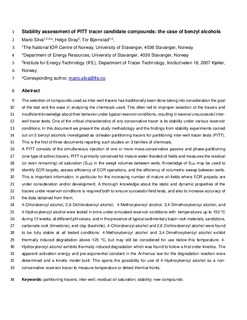| dc.contributor.author | Silva, Mario | |
| dc.contributor.author | Stray, Helge | |
| dc.contributor.author | Bjørnstad, Tor | |
| dc.date.accessioned | 2018-07-05T09:32:23Z | |
| dc.date.available | 2018-07-05T09:32:23Z | |
| dc.date.created | 2018-04-10T13:04:20Z | |
| dc.date.issued | 2018-04 | |
| dc.identifier.citation | Silva, M., Stray, H., Bjørnstad, T. (2018) Stability assessment of PITT tracer candidate compounds: the case of benzyl alcohols. Journal of Petroleum Science and Engineering, 167, pp. 517-523. | nb_NO |
| dc.identifier.issn | 0920-4105 | |
| dc.identifier.uri | http://hdl.handle.net/11250/2504479 | |
| dc.description.abstract | The selection of compounds used as inter-well tracers has traditionally been done taking into consideration the goal of the test and the ease in analyzing the chemicals used. This often led to improper selection of the tracers and insufficient knowledge about their behavior under typical reservoir conditions, resulting in several unsuccessful inter-well tracer tests. One of the critical characteristics of any conservative tracer is its stability under various reservoir conditions. In this document we present the study methodology and the findings from stability experiments carried out on 5 benzyl alcohols investigated as oil/water partitioning tracers for partitioning inter-well tracer tests (PITT). This is the first of three documents reporting such studies on 3 families of chemicals.
A PITT consists of the simultaneous injection of one or more mass-conservative passive and phase-partitioning (one type of active) tracers. PITT is primarily conceived for mature water-flooded oil fields and measures the residual (or even remaining) oil saturation (SOR) in the swept volumes between wells. Knowledge of SOR may be used to identify EOR targets, assess efficiency of EOR operations, and the efficiency of volumetric sweep between wells. This is important information, in particular for the increasing number of mature oil-fields where EOR projects are under consideration and/or development. A thorough knowledge about the static and dynamic properties of the tracers under reservoir conditions is required both to ensure successful field tests, and also to increase accuracy of the data obtained from them.
4-Chlorobenzyl alcohol, 2,6-Dichlorobenzyl alcohol, 4-Methoxybenzyl alcohol, 3,4-Dimethoxybenzyl alcohol, and 4-Hydroxybenzyl alcohol were tested in brine under simulated reservoir conditions with temperatures up to 150 °C during 12 weeks, at different pH values, and in the presence of typical sedimentary basin rock materials, sandstone, carbonate rock (limestone), and clay (kaolinite). 4-Chlorobenzyl alcohol and 2,6-Dichlorobenzyl alcohol were found to be fully stable at all tested conditions. 4-Methoxybenzyl alcohol and 3,4-Dimethoxybenzyl alcohol exhibit thermally induced degradation above 125 °C, but may still be considered for use below this temperature. 4-Hydroxybenzyl alcohol exhibits thermally induced degradation which was found to follow a first order kinetics. The apparent activation energy and pre-exponential constant in the Arrhenius law for the degradation reaction were determined and a kinetic model built. This opens the possibility for use of 4-Hydroxybenzyl alcohol as a non-conservative reservoir tracer to measure temperature or detect thermal fronts. | nb_NO |
| dc.language.iso | eng | nb_NO |
| dc.publisher | Elsevier | nb_NO |
| dc.rights | Attribution-NonCommercial-NoDerivatives 4.0 Internasjonal | * |
| dc.rights.uri | http://creativecommons.org/licenses/by-nc-nd/4.0/deed.no | * |
| dc.subject | petroleumsteknologi | nb_NO |
| dc.subject | petroleum technology | nb_NO |
| dc.subject | partitioning tracers | nb_NO |
| dc.subject | inter-well | nb_NO |
| dc.subject | residual oil saturation | nb_NO |
| dc.subject | new compounds | nb_NO |
| dc.subject | stability | nb_NO |
| dc.title | Stability assessment of PITT tracer candidate compounds: the case of benzyl alcohols | nb_NO |
| dc.type | Journal article | nb_NO |
| dc.type | Peer reviewed | nb_NO |
| dc.description.version | acceptedVersion | nb_NO |
| dc.rights.holder | (c) 2018 Elsevier B.V. All rights reserved. | nb_NO |
| dc.subject.nsi | VDP::Technology: 500::Rock and petroleum disciplines: 510::Petroleum engineering: 512 | nb_NO |
| dc.source.pagenumber | 517-523 | nb_NO |
| dc.source.volume | 167 | nb_NO |
| dc.source.journal | Journal of Petroleum Science and Engineering | nb_NO |
| dc.identifier.doi | 10.1016/j.petrol.2018.04.027 | |
| dc.identifier.cristin | 1578577 | |
| dc.relation.project | Norges forskningsråd: 230303 | nb_NO |
| cristin.unitcode | 217,8,6,0 | |
| cristin.unitcode | 217,0,0,0 | |
| cristin.unitname | Institutt for petroleumsteknologi | |
| cristin.unitname | Universitetet i Stavanger | |
| cristin.ispublished | true | |
| cristin.fulltext | postprint | |
| cristin.qualitycode | 2 | |

